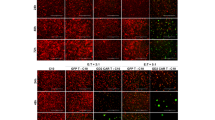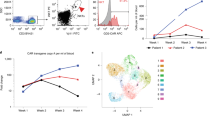Abstract
We have previously shown that expanded/activated γδ T cells from healthy donors are cytotoxic to GBM cell lines and primary GBM explants. In this report, we examined the therapeutic effect of intracranial infusion of expanded/activated γδ T cells on human minimal and established U251 tumor xenografts in athymic nude mice. Immunohistochemistry was used to determine the presence of NKG2D ligands on cell lines and tumors, and blocking studies were used to determine the effect of these ligands on γδ T cell recognition. Expanded/activated γδ T cells were prepared by 18-day culture in RPMI, human serum (HS), anti-CD2, IL-12, IFN-γ, and OKT-3. Anti-GBM activity of the cell product was assessed using in vitro cytotoxicity assays against the GBM cell line U251MG in suspension and in adherent culture. Ex vivo expanded/activated γδ T cells were of the effector/memory phenotype, expressed Th1 cytokines, and effectively killed U251 cells in vitro. Xenografts were prepared using a U251 cell line following transfection with a firefly luciferase gene to monitor tumor progression. Mice treated with γδ T cells showed slower progression of both new and established GBM xenografts versus mice that received vehicle only as determined by photon emission over time. Median survival was improved in all γδ T cell treated groups between 32 and 50 days by Kaplan–Meier analysis. U251 cells expressed ULBP-2 and ULBP-3, although blocking of these reduced in vitro cytotoxicity of γδ T cells to U251MG by only 33 and 25%, respectively. These studies show that expanded/activated γδ T cells can mediate killing of new or established GBM xenografts, reduce tumor progression, and constitute a potentially effective novel immunotherapeutic strategy against GBM.








Similar content being viewed by others
References
Castro MG, Cowen R, Williamson IK, David A, Jimenez-Dalmaroni MJ, Yuan X, Bigliari A, Williams JC, Hu J, Lowenstein PR (2003) Current and future strategies for the treatment of malignant brain tumors. Pharmacol Ther 98:71–108
Boiardi A, Silvani A, Ruffini PA, Rivoltini L, Parmiani G, Broggi G, Salmaggi A (1994) Loco-regional immunotherapy with recombinant interleukin-2 and adherent lymphokine-activated killer cells (A-LAK) in recurrent glioblastoma patients. Cancer Immunol Immunother 39:193–197
Yu JS, Liu G, Ying H, Yong WH, Black KL, Wheeler CJ (2004) Vaccination with tumor lysate-pulsed dendritic cells elicits antigen-specific, cytotoxic T-cells in patients with malignant glioma. Cancer Res 64:4973–4979
Merchant RE, Baldwin NG, Rice CD, Bear HD (1997) Adoptive immunotherapy of malignant glioma using tumor-sensitized T lymphocytes. Neurol Res 19:145–152
Plautz GE, Barnett GH, Miller DW, Cohen BH, Prayson RA, Krauss JC, Luciano M, Kangisser DB, Shu S (1998) Systemic T cell adoptive immunotherapy of malignant gliomas. J Neurosurg 89:42–51
Merchant RE, Ellison MD, Young HF (1990) Immunotherapy for malignant glioma using human recombinant interleukin-2 and activated autologous lymphocytes. A review of pre-clinical and clinical investigations. J Neurooncol 8:173–188
Barba D, Saris SC, Holder C, Rosenberg SA, Oldfield EH (1989) Intratumoral LAK cell and interleukin-2 therapy of human gliomas. J Neurosurg 70:175–182
Saris SC, Patronas NJ, Rosenberg SA, Alexander JT, Frank J, Schwartzentruber DJ, Rubin JT, Barba D, Oldfield EH (1989) The effect of intravenous interleukin-2 on brain water content. J Neurosurg 71:169–174
Hayes RL, Koslow M, Hiesiger EM, Hymes KB, Hochster HS, Moore EJ, Pierz DM, Chen DK, Budzilovich GN, Ransohoff J (1995) Improved long term survival after intracavitary interleukin-2 and lymphokine-activated killer cells for adults with recurrent malignant glioma. Cancer 76:840–852
Dillman RO, Duma CM, Schiltz PM, DePriest C, Ellis RA, Okamoto K, Beutel LD, De Leon C, Chico S (2004) Intracavitary placement of autologous lymphokine-activated killer (LAK) cells after resection of recurrent glioblastoma. J Immunother 27:398–404
Quattrocchi KB, Miller CH, Cush S, Bernard SA, Dull ST, Smith M, Gudeman S, Varia MA (1999) Pilot study of local autologous tumor infiltrating lymphocytes for the treatment of recurrent malignant gliomas. J Neurooncol 45:141–157
Kruse CA, Cepeda L, Owens B, Johnson SD, Stears J, Lillehei KO (1997) Treatment of recurrent glioma with intracavitary alloreactive cytotoxic T lymphocytes and interleukin-2. Cancer Immunol Immunother 45:77–87
Read SB, Kulprathipanja NV, Gomez GG, Paul DB, Winston KR, Robbins JM, Kruse CA (2003) Human alloreactive CTL interactions with gliomas and with those having upregulated HLA expression from exogenous IFN-gamma or IFN-gamma gene modification. J Interferon Cytokine Res 23:379–393
Komatsu F, Kajiwara M (2000) CD18/CD54 (+CD102), CD2/CD58 pathway-independent killing of lymphokine-activated killer (LAK) cells against glioblastoma cell lines T98G and U373MG. Oncol Res 12:17–24
Wischhusen J, Friese MA, Mittelbronn M, Meyermann R, Weller M (2005) HLA-E protects glioma cells from NKG2D-mediated immune responses in vitro: implications for immune escape in vivo. J Neuropathol Exp Neurol 64:523–528
Wiendl H, Mitsdoerffer M, Hofmeister V, Wischhusen J, Bornemann A, Meyermann R, Weiss EH, Melms A, Weller M (2002) A functional role of HLA-G expression in human gliomas: an alternative strategy of immune escape. J Immunol 168:4772–4780
Hacker G, Kromer S, Falk M, Heeg K, Wagner H, Pfeffer KV (1992) Delta 1+ subset of human gamma delta T cells responds to ligands expressed by EBV-infected Burkitt lymphoma cells and transformed B lymphocytes. J Immunol 149:3984–3989
Bryant NL, Suarez-Cuervo C, Gillespie GY, Markert JM, Nabors LB, Meleth S, Lopez RD, Lamb LS Jr (2009) Characterization and immunotherapeutic potential of {gamma}{delta} T cells in patients with glioblastoma. Neuro-Oncology 11:357–367
Girardi M, Oppenheim DE, Steele CR, Lewis JM, Glusac E, Filler R, Hobby P, Sutton B, Tigelaar RE, Hayday AC (2001) Regulation of cutaneous malignancy by gamma delta T cells. Science 294:605–609
Liu Z, Eltoum IE, Guo B, Beck BH, Cloud GA, Lopez RD (2008) Protective immunosurveillance and therapeutic antitumor activity of gamma delta T cells demonstrated in a mouse model of prostate cancer. J Immunol 180:6044–6053
Ferrarini M, Pupa SM, Zocchi MR, Rugarli C, Menard S (1994) Distinct pattern of HSP72 and monomeric laminin receptor expression in human lung cancers infiltrated by gamma/delta T lymphocytes. Int J Cancer 57:486–490
Choudhary A, Davodeau F, Moreau A, Peyrat MA, Bonneville M, Jotereau F (1995) Selective lysis of autologous tumor cells by recurrent gamma delta tumor-infiltrating lymphocytes from renal carcinoma. J Immunol 154:3932–3940
Zhao X, Wei YQ, Kariya Y, Teshigawara K, Uchida A (1995) Accumulation of gamma/delta T cells in human dysgerminoma and seminoma: roles in autologous tumor killing and granuloma formation. Immunol Investig 24:607–618
Bagot M, Heslan M, Dubertret L, Roujeau JC, Tourine R, Levy JP (1985) Antigen presenting properties of human epidermal cells compared with peripheral blood mononuclear cells. Br J Dermatol 113(Suppl 28):55
Fujimiya Y, Suzuki Y, Katakura R, Miyagi T, Yamaguchi T, Yoshimoto T, Ebina T (1997) In vitro interleukin 12 activation of peripheral blood CD3(+)CD56(+) and CD3(+)CD56(−) gamma delta T cells from glioblastoma patients. Clin Cancer Res 3:633–643
Yamaguchi T, Suzuki Y, Katakura R, Ebina T, Yokoyama J, Fujimiya Y (1998) Interleukin-15 effectively potentiates the in vitro tumor-specific activity and proliferation of peripheral blood gamma delta T cells isolated from glioblastoma patients. Cancer Immunol Immunother 47:97–103
Lopez RD, Xu S, Guo B, Negrin RS, Waller EK (2000) CD2-mediated IL-12-dependent signals render human gamma-delta T cells resistant to mitogen-induced apoptosis, permitting the large-scale ex vivo expansion of functionally distinct lymphocytes: implications for the development of adoptive immunotherapy strategies. Blood 96:3827–3837
Guo B, Hollmig K, Lopez RD (2002) Down-regulation of IL-2 receptor a (CD25) characterizes human gd-T cells rendered resistant to apoptosis after CD2 engagement in the presence of IL-12. Cancer Immunol Immunother 50:625–637
Friese MA, Platten M, Lutz SZ, Naumann U, Aulwurm S, Bischof F, Buhring HJ, Dichgans J, Rammensee HG, Steinle A, Weller M (2003) MICA/NKG2D-mediated immunogene therapy of experimental gliomas. Cancer Res 63:8996–9006
Otto M, Barfield RC, Iyengar R, Gatewood J, Muller I, Holladay MS, Houston J, Leung W, Handgretinger R (2005) Human gamma delta T cells from G-CSF-mobilized donors retain strong tumoricidal activity and produce immunomodulatory cytokines after clinical-scale isolation. J Immunother 28:73–78
Radaelli E, Ceruti R, Patton V, Russo M, Degrassi A, Croci V, Caprera F, Stortini G, Scanziani E, Pesenti E, Alzani R (2009) Immunohistopathological and neuroimaging characterization of murine orthotopic xenograft models of glioblastoma multiforme recapitulating the most salient features of human disease. Histol Histopathol 24:879–891
Kaminski MJ, Cruz PD Jr, Bergstresser PR, Takashima A (1993) Killing of skin-derived tumor cells by mouse dendritic epidermal T-cells. Cancer Res 53:4014–4019
Groh V, Steinle A, Bauer S, Spies T (1998) Recognition of stress-induced MHC molecules by intestinal epithelial gamma delta T cells. Science 279:1737–1740
Wu J, Groh V, Spies T (2002) T cell antigen receptor engagement and specificity in the recognition of stress-inducible MHC class I-related chains by human epithelial gamma delta T cells. J Immunol 169:1236–1240
Morita CT, Mariuzza RA, Brenner MB (2000) Antigen recognition by human gamma delta T cells: pattern recognition by the adaptive immune system. Springer Semin Immunopathol 22:191–217
Bauer S, Groh V, Wu J, Steinle A, Phillips JH, Lanier LL, Spies T (1999) Activation of NK cells and T cells by NKG2D, a receptor for stress-inducible MICA [see comments]. Science 285:727–729
Groh V, Rhinehart R, Secrist H, Bauer S, Grabstein KH, Spies T (1999) Broad tumor-associated expression and recognition by tumor-derived gamma delta T cells of MICA and MICB. Proc Natl Acad Sci USA 96:6879–6884
O’Brien RL, Roark CL, Jin N, Aydintug MK, French JD, Chain JL, Wands JM, Johnston M, Born WK (2007) Gamma delta T-cell receptors: functional correlations. Immunol Rev 215:77–88
Castriconi R, Daga A, Dondero A, Zona G, Poliani PL, Melotti A, Griffero F, Marubbi D, Spaziante R, Bellora F, Moretta L, Moretta A, Corte G, Bottino C (2009) NK cells recognize and kill human glioblastoma cells with stem cell-like properties. J Immunol 182:3530–3539
Ferrarini M, Delfanti F, Gianolini M, Rizzi C, Alfano M, Lazzarin A, Biswas P (2008) NF-kappa B modulates sensitivity to apoptosis, proinflammatory and migratory potential in short- versus long-term cultured human gamma delta lymphocytes. J Immunol 181:5857–5864
Gan YH, Wallace M, Malkovsky M (2001) Fas-dependent, activation-induced cell death of gamma delta cells. J Biol Regul Homeost Agents 15:277–285
Author information
Authors and Affiliations
Corresponding author
Additional information
This study was supported by NIH NCI Grant # P50 CA 097247, NINDS Grant # R21 NS 57341 and the National Brain Tumor Society Samuel Gerson Leadership Chair.
Rights and permissions
About this article
Cite this article
Bryant, N.L., Gillespie, G.Y., Lopez, R.D. et al. Preclinical evaluation of ex vivo expanded/activated γδ T cells for immunotherapy of glioblastoma multiforme. J Neurooncol 101, 179–188 (2011). https://doi.org/10.1007/s11060-010-0245-2
Received:
Accepted:
Published:
Issue Date:
DOI: https://doi.org/10.1007/s11060-010-0245-2




